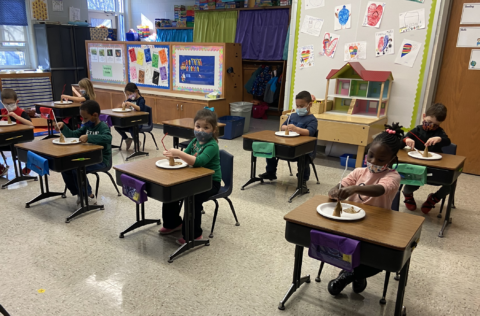What was your driving question?
How do birds survive in the winter?
Grades Involved
Kindergarten
What PBE principles were highlighted in this project?
Learner-Centered, Design Thinking, Inquiry-Based
Project Description
Students were learning about how animals survive in the winter in their Science classes. The students wanted to know how birds find food in the winter months, so they began researching and found out that people can provide food for birds in the winter. The students decided to make a variety of bird feeders to hang outside their classroom windows and hang a bird camera to help them observe the birds even if they were not in school.

Students made the bird feeders using sugar cones, sun butter, birdseed (containing no nuts since there is a peanut allergy in the classroom), and cereal. Students hung the bird feeders on the tomato plant cages we placed outside using pipe cleaners to hang them.
The nature camera was then placed outside to see what types of birds we could capture eating from our feeders. A bird chart was placed in the classroom showing different types of birds in Missouri, and students used it to help identify birds we saw on the camera pictures and outside our window.

In about four days, our camera had captured over 400 photos of birds. The students would ask to view the photos of the birds during their snack time because they wanted to see what had been eating their feeders!
Students observe, identify and record what birds they observed. As the winter progresses students will provide different types of foods to see what birds are coming to different types of foods. They have been practicing their observation skills and noticing details of different birds. They used these observations to create drawings of one of their frequent bird visitors, the Northern Cardinal.

How did this project connect to your local or regional community?
Students designed feeders to feed birds living around their schoolyard.
How did this positively impact the community? How was it shared?
They have provided for birds in their local community and many students have shared their learning at home, which has led to families putting up feeders and students observing birds at home and sharing their findings with their classmates.
Reflection: What was the biggest challenge? What was the most rewarding aspect of this project?
The biggest challenge was transitioning between virtual and in-seat learning. It was also time-consuming to sort through all of the photos. There were over 400 pictures after just four days! The kids’ excitement and engagement in the project were truly rewarding.
Any advice for a teacher or student that is implementing a PBE project for the first time?
Let the students’ curiosity guide your project.

